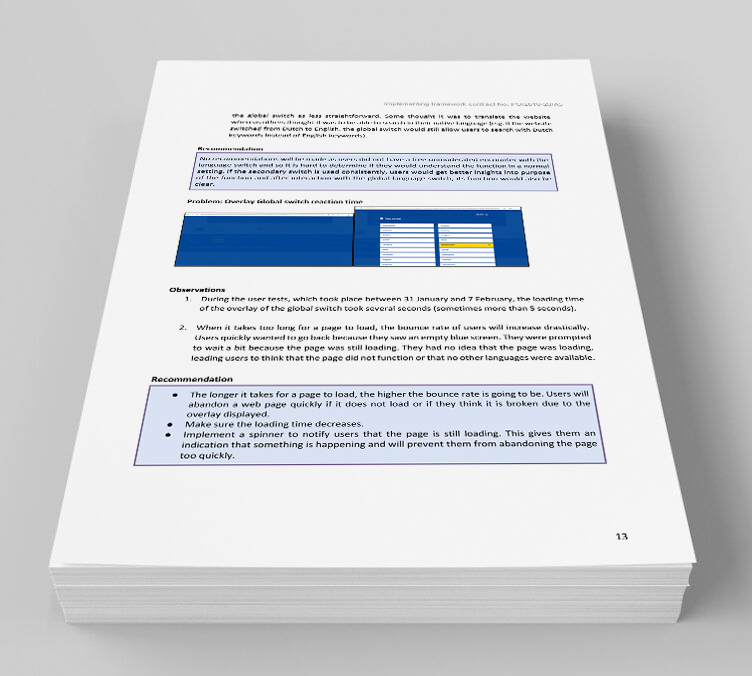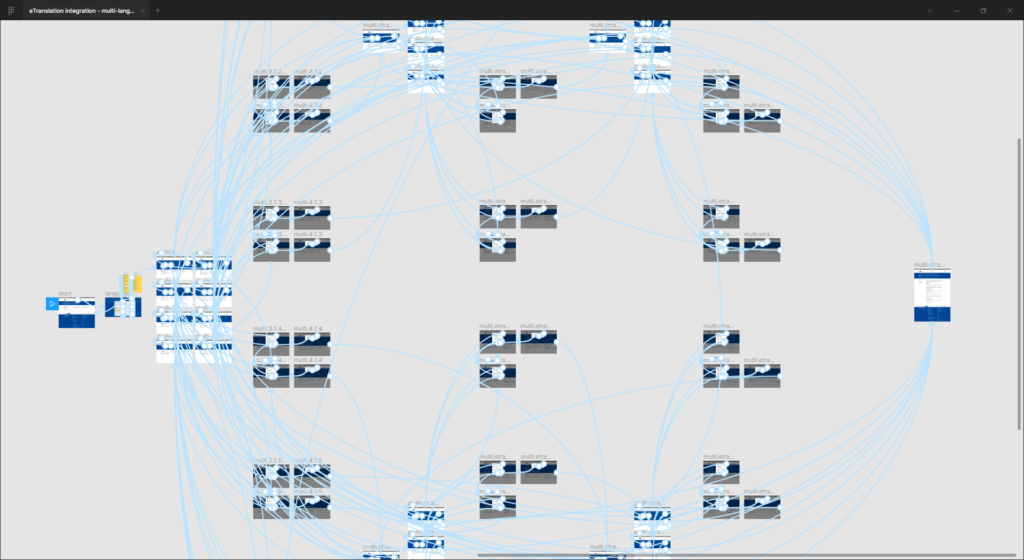
Case Study
Machine translation integration
Categories
- Heuristic Review
- Prototyping
- Stakeholder interview
- Usability Test
- User interviews
- UX
- Wireframing
Software
- Figma
- Miro
- Sketch
Project goal
The current language concept tool of the European Commission conflicts with their new machine translation tool, when they are both implemented on a website. The goal of the project is to create a harmonious union of the two tools. The machine translation tool has not been tested with users and has only gone through User Acceptance Tests(UAT). The stakeholders would also like the machine translation tool to be tested with users, since this has not yet occurred.
My Role and tasks
My role
My role in this task was to plan and conduct user research, and propose a harmonious integration of tools when they are used together on a website, and in conjunction, test the machine translation tool for possible other user needs. User research was the core of this project; the user needs extracted from the research were the basis for the opportunities we identified.
- Planned tasks for team members in order to meet the project goals
- Reviewed existing pre-discovery research and extracted user needs
- Conducted user and stakeholder interviews and categorised user and stakeholder needs.
- Planned and organised recruitment of participants
- Created moderated usability test guide
- Conducted moderated usability tests and analysed results
- Presented findings and proposals
My tasks
- Weekly demos to stakeholders
- Sketching
- Storyboarding & wireframing in Miro
- Mentoring of team members
- Creating prototype in Figma
- Moderating and conducting research interviews and moderated usability test
- Analysing and summarising results
Previous research

In order to start the project, I first had to get a better understanding of what has been done before. I had to emerge myself in the history and previous research on both of these tools. The machine translation tool is fairly new, which is in contrast of the Language Concept, which had a lot of research. Once I had a clearer picture of the past research I prepared a research plan.
Which conflicts exist between the two tools?
Interviews
Stakeholder interviews were conducted in order to find out about limitations, hidden concerns or ideas they might have. User interviews were conducted in order to gather insights regarding their opinion on improving the tools, their perceived usage and importance of each tool, and the process they follow when using the tools.
Key findings
- Users were lost throughout key tasks
- Users did not know why the content appears in more than one language
- Users did not know why there are two language selectors
- Stakeholders revealed that they would like to have the machine translation tool to function not only for multilingual websites, but that it should also provide language options on websites that only have one language option.
Heuristic review
A heuristic review was done in order to slot in the current needs identified with the heuristics and then use these heuristics as an KPI of improvement along the process.
Heuristic issues identified

Key heuristic issues were identified to be either lacking or non existent.
- Visibility of the system status
- User control & freedom
- Error prevention
- Consistency and standards
- Recognition rather than recall
Ideate possible solutions
Once the user needs and stakeholder concerns were identified, we were able to start on the ideation of possible solutions with this information as well as using UX heuristics to guide the process.

Limitations and risks
More than one solution came out on top in the ideation process. Once wireframes were created, I presented them to key stakeholders in order to have some of the assumptions answered on the functionality of the machine translation tool, and with this information eliminate some proposed solutions.
Prototyping
With some proposals removed from the process and the remaining proposal refined, mockups, and then prototypes were created for a mono-language and a multi-language proposal for testing purposes.

Testing
- A test guide was created with the key tasks that were identified during the user interviews, and previous Language Concept tests and research.
- Scenarios were created
- Recruited 5 participants for each version and platform(desktop & mobile)
- KPIs to measure and reuse in future tests have been identified
- Pre-test was done in order to make sure that the test is fit for purpose and that the test doesn't take too long to complete.
Moderated usability testing was carried out, either by myself or team a member who I would oversee and mentor. The results did not level out during the test, and because of this the test was carried out on all 5 users for each test.
Outcome
The report
The final report showed that all the previous heuristic issues had been addressed and amended in this new version, and that users are able to complete all tasks without encountering any blockers.
Other comments were noted, such as the system status indicator taking up a lot of space. The users did mention however that this isn’t really a problem for them, since they are able to close the container if they don't want to see it.
The key heuristic issues that were identified
- Visibility of the system status - a situational notification system had been introduced into the system
- User control & freedom - Tasks can now be interrupted when a user has taken an unwanted action without having to go through an extended process in order to do so
- Error prevention - a situational notification system had been introduced into the system
- Consistency and standards - the design of the tools were made consistent with the rest of the website, by following their own brand guidelines
- Recognition rather than recall - the design was refined and made simpler
The Proposal
The final proposal was created and presented to the stakeholders. It was decided that the new versions of the language tools will be implemented and monitored through the feedback form and analytics.
